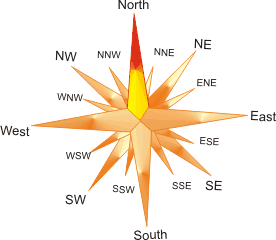Vastu Shastra is an ancient Indian technique that helps people achieve more peace and wealth by removing bad energy and strengthening positive energy in their surroundings. While we spend the majority of our time at home, we want it to be filled with positive energy that will allow us to relax and unwind. Vastu is a science of direction that balances everything by combining the five components of nature and the universe.
One of the most commonly asked questions in Vastu Shastra is how to use the compass to determine the house’s face. It’s a crucial question since Vastu shastra, the ancient building science is fully direction-based, and directions are regarded as energy centers in Vastu shastra.
As a result, if your compass reading seems to be off, you won’t be able to make your house Vastu compliant because even a change of 3-4 degrees will throw off the entire computation of 16 Vastu zones. It will also make it more difficult for you to figure out what’s causing the issues.
As a result, in order to effectively use all of the Vastu concepts, you must first determine the exact directions of your home. Determining the instructions might be a very complicated and tough task at first.
What is a Vastu Compass?
People used to use the sun’s shadow to identify directions back in the day. In today’s technologically evolved world, we can use a magnetic instrument called a compass to double-check directions. Essentially, a compass is a gadget with a magnetic needle that assists us in determining the direction of the Earth’s magnetic poles.
This magnetic needle is balanced on a pivot point that is practically frictionless. The one end of the compass needle is frequently colored red or green, or marked with an ‘N,’ indicating that it points in the direction of North. The magnetic compass needle aligns itself with the earth’s magnetic field on one end, indicating that it will always point to the magnetic North of the earth, which is distinct from the geographic North.
Reading a compass accurately is likewise a skill that not everyone has mastered, despite the fact that minor variations due to human error are trivial. Vastu compasses come in two types, both of which are widely available in the market. Pivotal compass and floating compass are the two types of compass.

Source – Vastu Shastra
Points to Note While Using a Compass
- When using a compass, keep the following crucial points in mind:
- Make sure you’re not near any structures that could interfere with the magnetic needle and thus the compass reading.
- Carry no mobile phone, laptop, or iron item.
- While using the compass, make sure there are no high-voltage electrical lines nearby.
- Make sure there are no magnetic objects in the vicinity of the compass.
- Remove all jewelry from your hands and wrists, as it may obstruct your reading.
How to correctly identify the facing of your home?
Assume that the front of your house i.e., the main gate faces a park. You’ll need to stand parallel to a wall with your face facing the park to get a compass reading. Keep your elbow at 90 degrees (horizontally) at chest level while holding the compass in your palm. Rotate the housing dial with your hand as steady as possible until the compass needle (typically a red or green colored tip) lines up with the orienting arrow.
Determine which line is immediately in front of you once the 0°/360° mark on the compass housing and the North end of the needle are aligned. To put it another way, the compass line directly in front of you indicates the actual degree or face of your home. Let’s say the compass reading is 45 degrees (North-East). Then your house’s aspect will be North-East (NE).
To identify the correct direction, take at least three readings from different locations of your house or land. The three readings may occasionally disagree. In that instance, put all three readings together and divide by three, for example, 130+128+132=390 divided by three equals 130 degrees. It will be the home’s front.
Your house will now have an accurate facing. You must also determine the exact North point of your home in order to create a Vastu-compliant floor layout. Let’s say you’re facing a specific wall on your property and the compass reading is 45°. Measure 45° anti-clockwise from that point on the map, facing the same wall, and that’s the North direction of your house.
Positive energy flow in all 16 Vastu zones of your home is critical for achieving the desired results, as this flow has a significant impact on your emotions and thoughts. As a result, it’s critical to pinpoint the 16 Vastu zones on the globe and make them Vastu-friendly. Four cardinal, four inter-cardinal, and eight secondary inter-cardinal directions make up the 16 Vastu zones. Each of them is placed on a specific compass degree. The four inter-cardinal (ordinal) directions are subdivided from the cardinal directions. Each inter-cardinal direction is situated in the middle of two cardinal directions.


